Why does Obsidian lead to a confusing Zettelkasten?
This discussion was created from comments split from: Zettelkasten method and math related sciences.
For context:
For context:
@ulver48 said:
But with respect to the Zettelkasten, the only software that I found easy to use is the zkn3. I am on Linux, so I cannot use the Archive. Obsidian led to a very confusing slip-box and I quickly abandoned it. Is there any articles for building a Zettelkasten from tex files ?
But with respect to the Zettelkasten, the only software that I found easy to use is the zkn3. I am on Linux, so I cannot use the Archive. Obsidian led to a very confusing slip-box and I quickly abandoned it. Is there any articles for building a Zettelkasten from tex files ?
Howdy, Stranger!
Comments
@ulver48,
Can you please tell us a bit about how Obsidian led you to have a confusing ZK?
@ulver48 I'm also interested in what specific problems you encountered with Obsidian, since I use it daily as a ZK processing tool quite effectively.
Hello folks.
I guess its because I couldn't see effectively my train of thought with Obsidian, which would also be the case if I were to use a plain text approach or the original card approach as it was used by Luhmann. I had the notes with the ID and the title, but (a) the graph display was starting to become very complex and (b) I couldn't see my ideas in a hierarchical structure as I can in the Zkn3 software (See next figure as an example from my slip-box)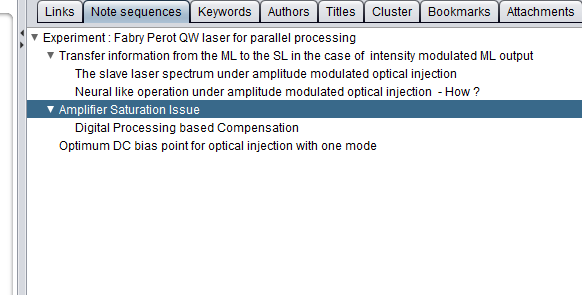
I find this tree-like view very easy to follow. If you find the Obsidian so useful then can you suggest a guide or a tutorial on how to use it efficiently ? Most youtube videos didn't help so much. For now, I will stick with the ZKn3 software.
Ah I see, you are looking for an equivalent built-in capability that leverages the Luhmann ID hierarchy.
Counterpoint: Here is a note I have in Obsidian right now.
I find this orders the thoughts quite well.
It also enables the same thoughts to be referenced from multiple outlines.
For example, here is a small snippet from another note on Security Engineering that includes
Prefer abstractions built on trustworthy componentsandAbstractions leaksince they apply to both contexts. (and thus acts as a bridge between the two domains)Other reading on outline notes:
Wow, very nice. I will give Obsidian another shot. Thanks.
I will have to find a way however to transfer my notes from the Zkn3 slip-box to the Obsidian one.
Before you spend a bunch of time transferring all your notes, why don't you test drive Obsidian further (with a small, perhaps newly created set of data) and make sure it works the way you want it to? I tried out a couple of other bits of software (including Zettlr, Tiddlywiki and Obsidian) but kept coming back to The Archive. The point, though, is not that The Archvie is the perfect software. It is that if you are contemplating a switch (from one piece of software to another), and that switch has a bunch of overhead, then make sure the new software has sufficient advantages and little downside. The more effort needed to switch, the more carefully you want to check the "new and possibly better" software out.
@ulver48 said:
this type of notes can also be created with The Archive, btw.
my first Zettel uid: 202008120915
I wanted to give a small update. I created in Obsidian an Index from where I am able to navigate in specific key areas.
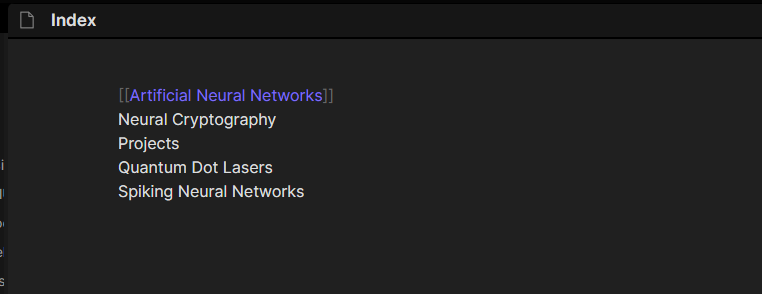
From there I created a hub note that leads me to specific sub-areas
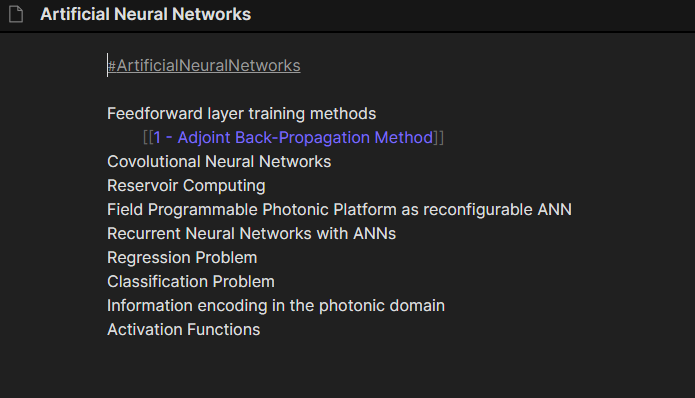
Afterwards, I can created the hierarchy I needed by using the Luhman's ID numbering (1, 1a, 1a1, etc). For instance this is an introductory note on a subject along with the structure of my thoughts in the links below.
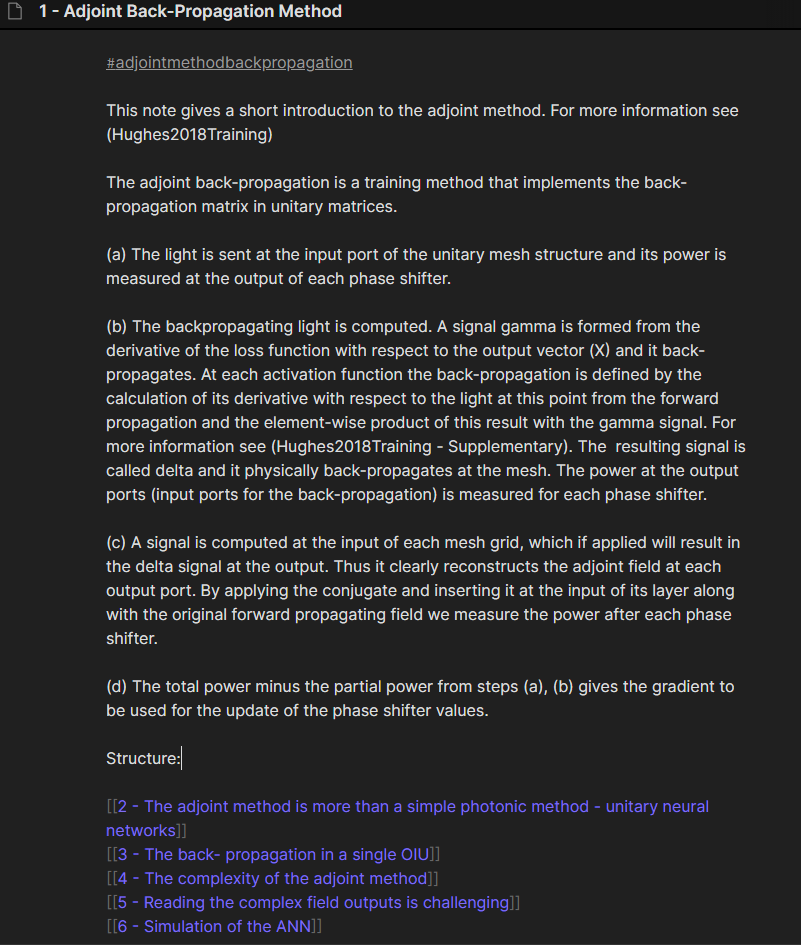
The same thing in Zkn3 is
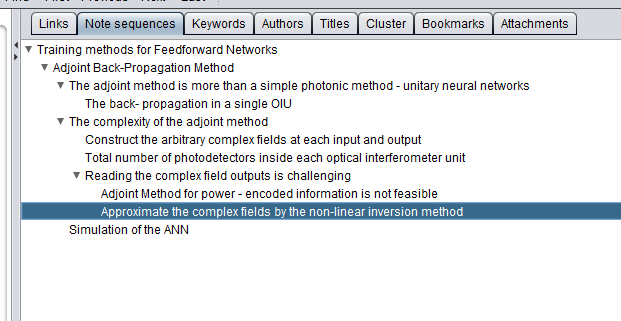
Truth to be told Zkn3 looks far more friendly but I have no problem navigating in Obsidian by organizing notes in this way.
Any further suggestions ?
yes, maybe. I am not very familiar with Zkn3 so i don't completely understand your comparison - where are your hubs and indexes in Zkn3? Where is your note sequence in Obsidian?
What you have in Zkn3 can be represented with any text editor when using outlines:
- Training methods for Feedforward Networks + Adjoint Back-Propagation methods * The adjoint method is more than a simple photonic method - unitary neural Networks - the back-propagation in a single OIU * the complexity of the adjoint method - construct the arbitrary complex fileds at each input and output - total number of photodetectors inside each optical interferometer unit - reading the complex field outputs is challenging + adjoint method for power - encoded information is not feasible + approximate the complex fields by the non-linear inversion method - simulation of the ANNModify the sequence within a single text file. For navigation you then add a hyperlink on any line.
my first Zettel uid: 202008120915
In Obsidian I thought that it would be better not to create such an extensive list. I could use the IDs for navigation. For instance here is the full picture again.
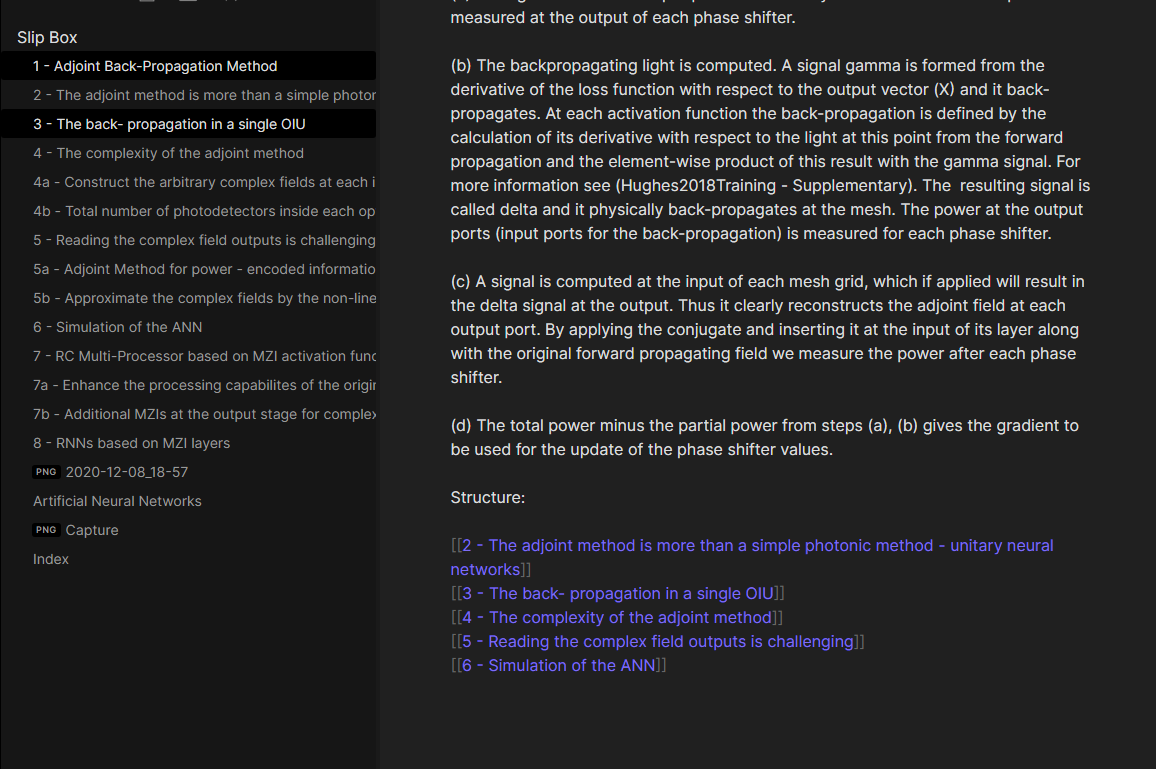
I can choose the 5th note and from there I can go to the 5a or 5b notes which refer to this one. The hierarchy can be seen on the left. So, if I want to create a new note sequence expanding on 5a, I can create a new note with index 5a1. Thus I can navigate from the main hub to 5 and from there to 5a or 5b, from 5a to 5a1, etc. The note "Adjoint Back-propagation methods" is just the entry point to different sequences with thoughts regarding this particular concept.
In ZKn3 here is my index
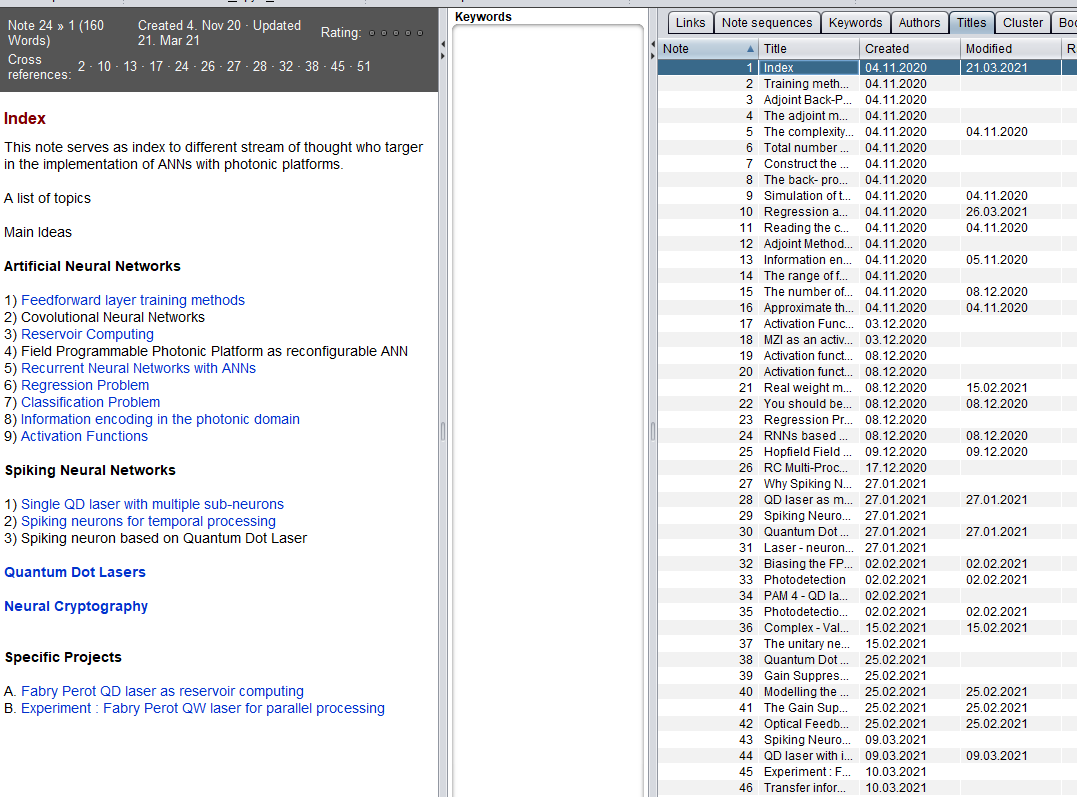
From there, I could choose the "Feedforward layer training methods" that would lead to me the note "Training methods for Feedforward networks" and it would show on the right the tree-diagram that you see in the previous post. From there I can navigate to different notes which I can see in an organized manner.
I agree with @GeoEng51, try it out before you do any conversion. You don't want to end up spending time converting only to find it does not meet your needs.
Also if you are looking for nothing more than note taking and linking there are multiple apps that can do that and I recommend trying more than just Obsidian. Outline notes like I described can be made in any of the apps that support linking notes together.
I responded since you specifically asked about Obsidian, not to state it is inherently better than one of the other apps. (I have my own biases since it meets my needs better than the several other apps I tried, but that's personal preference, not objective fact, and it may not meet your needs)
Well, what I find problematic in the way I created by previous slip-box is the IDs that I used. Using the Year/Month/Day/Hour/Minute format gives you no information on how the different notes are related. With Luhmann's approach, I can now jump from the index to the note 5 and from there go to the notes 5a, 5b etc. The 5a ID is a clear indicator that this note is the child of 5. In Zkn3 I had no problem with that due to its GUI, but in the text based environment of Obsidian this is not so simple. The tree-like hierarchy that I need comes in Obsidian naturally from the IDs.
Zkn3 allows you to navigate through your sequence while updating the note preview on change. Also, it is very convenient to navigate from one sequence to another. Likewise, navigation within the sequence. I think this is important when searching for alternative software.
I like this a lot about Zkn3.
my first Zettel uid: 202008120915
@ulver48 I'm curious what actual benefit you get from encoding hierarchy in the note titles themselves? How is this conceptually different than placing each note into its own enclosing folder?
I have a weird feeling there is something potentially beneficial in this approach but I'm just not seeing it.
Also Luhmann seems to have evolved his system from using the ID as the hierarchy of ideas into later referring to it solely as a means to get a unique ID for the note so it could be referenced later. This seems to be an evolution in his use of his slip box that I presume arose from seeing the power of the cross links, allowing him to relax the focus on the hierarchical IDs. He even said he would just throw a new note into the back of the ZK and give it the next sequential number if he didn't immediately know of a better place for it because it didn't matter as long as he had the unique ID to link the notes together. These links were in the form of links within other notes as well as his index notes and top-level notes. (what we would call index/hub/structure/MOC notes now)
The relationship is not inherent in the title of the notes with this approach. Instead it arises through the links in two ways:
With this there is no need for an inherent relationship through the note titles, as long as you update the relevant outline note(s).
So I'm not clear on whether the supposed benefit from the hierarchical ID is worth the effort. Would like your inputs since you feel you had success with it in zkn3.
@ulver48 how can i navigate through adjacent notes without going through its childs first? When i use arrow keys in the note sequence i can follow the childs first. There doesn't seem to be another way.
my first Zettel uid: 202008120915
@davecan I think the reason I find this method superior is that the structure itself starts to unfold spontaneously as you insert new notes. For example, if you take a look at Zkn3 I didn't created any structure note that needs to be updated with new entries. This hierarchy was created spontaneously. So I have no need to carefully manage any structure notes. I just go to the index, jump to the subject that interests me and I see all the interconnections between the notes reflected on the IDs. I think this is close to what Sohren suggests in his book.
Edit: Moreover, if at some point you want to create a structure note because you find things too messy then you can immediately extract one from the list since related notes are close together due to the IDs. If you look for example at 13 there is immediately a hierarchy and you can navigate at the concept 13a or 13b and so on.
If at some point things get messy, I can always create a new 13st note with the hierarchy
13a, 13b, 13c, etc. I think this approach makes jumping to notes much much easier.
I use the mouse in Zkn3, thus I don't have such a problem.
These are note sequences, there is no hierarchy. You use outlines for hierarchy. Zkn3 offers two completely separate views for both systems. You still have hubs, direct links within notes, etc.
I don't think this scales. I expect navigation to become more difficult over time due to proximity problem.
my first Zettel uid: 202008120915
I experimented with the Luhmann ID structure early on but found I was using it instead of linking between notes. That may have been a side effect of not having many notes in the system yet. But it seemed to be an anti-pattern to depend on titles to make implicit associations between notes so I moved away from it.
Though perhaps there is benefit in the idea that encoding an inter-note relationship through the ID provides a different semantic meaning than the links we create within the note itself. I'm not completely convinced of that but this ID system continues to scratch at my brain for some reason. It just feels like using these "folgezettel" has some form of power that is not readily apparent, but I can't be certain.
I suspect it is much more useful in academic circles where it is critical to trace the history of how ideas build on one another.
@davecan The hunch that Luhmann-Ids do something cool is very common. We have had a lot of discussion on the forums about the term "Folgezettel", and my personal summary of all of that is: it seems to be an attractive option, but none of the purported benefits (e.g. proxmitiy of related notes, encoding of hierarchy) scale as you continue to work. What is close together now eventually is torn apart by branches; and multiple hierarchies will become more useful to encode different 'views' into your ZK. Luhmann himself stressed that a fixed place is more important than where it is. The attractive early days eventually cease to last. -- No need for FOMO.
Author at Zettelkasten.de • https://christiantietze.de/
@ctietze So I guess one can use Luhmann-Ids but at some point he has to create hierarchy notes or else he will be lost in a sea full of branches. Even if it means taking an ID 343 and writing on it an outline with links at 343a, 343b, 343c, etc in case that the branches are too deep (i.e. there is a 343a12a23). In a few words you cannot avoid structure nodes.
He could just put all the relevant notes on a table.
I am a Zettler
My personal belief is that this is why Luhmann evolved and relaxed his thinking towards the use of the ID as a fixed address rather than a spatial sequencing, because he encountered exactly that issue of proximity. It's just difficult to see that when you have a much smaller body of notes. (mine is just under 1,000 now and growing)
This seems accurate to me. I trust the judgment of @Sascha and @ctietze who have been doing this and writing about it for nearly a decade. If the branching ID system was both useful and scalable then why haven't they adopted it? In zkn3 the ID system is hidden behind the software, which presumably makes it easier to use since you don't have to manage the IDs yourself, but if it worked at scale then why hasn't any other tool adopted it? Why did they not build it into The Archive after using zkn3 (presumably) for several years?
IIRC this is exactly what he did, as described in at least one of the journal articles, either his own or perhaps writings by Schmidt or Ludecke. Also I believe this is what the zkn3 "project" feature is intended to replicate, letting you "pull" notes from the ZK (creating shortcuts) that you can then arrange on the "table" (projects window/pane) as needed. It's been a while since I tinkered with zkn3 so I could be mistaken there.
No need for assumptions, just ask Zkn3 never clicked for me, and once I got to know Notational Velocity around 2009, I began to see how important portability of data is. (I also used DEVONthink at that time, but exporting notes was simple.) I never used Zkn3 for long.
Zkn3 never clicked for me, and once I got to know Notational Velocity around 2009, I began to see how important portability of data is. (I also used DEVONthink at that time, but exporting notes was simple.) I never used Zkn3 for long.
As to why The Archive does this and not that -- we strive to develop the most portable, most 'software-agnostic' note-taking app that is capable of implementing the principles of a Zettelkasten: the principles, not the literal practices of paper-based approaches. Outlines/structure notes encapsulate hierarchy, too, and don't box users into specific software. That's a prime reason. This doesn't neccessitate that we wouldn't like to experiment with other features and workflows; we just try to bring a simple approach to the world, instead.
Author at Zettelkasten.de • https://christiantietze.de/
Good for you!!
Oh thank god, I am not alone then!
Does anyone know if there is an efficient way to put all the relevant notes on the table in Obsidian ? I think that you can just create a new note named "Table" and start putting links there in order to navigate easily back and forth between various ideas. Has anyone a better suggestion ?
Any note can be a table for anything.
I am a Zettler
Exactly this @ulver48. Instead of thinking about the mechanics of the app think about the collection of the ideas. Since a note is just a collection of ideas then all you do is create a new note to collect them together.
This is also why I like the outline note structure so much, because it does half the work for you.
There is a plugin in Obsidian called Workbench that has commands to select notes, links, and text and extract them (copy or transclude) into the dedicated workbench note. This actually works similar to the sidebar in Roam which is pretty neat. You could name the workbench note "_ TABLE" or whatever you want and use that, if you don't want to use a "normal" note.
But you don't need that.